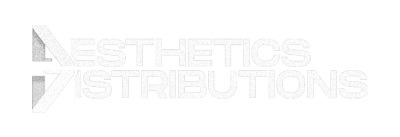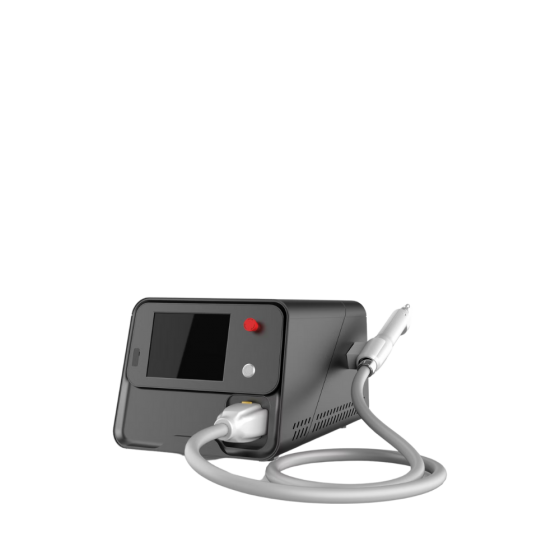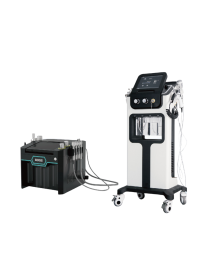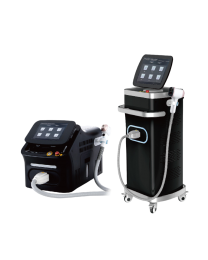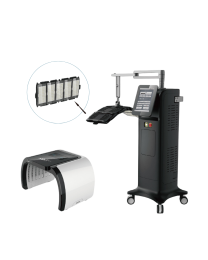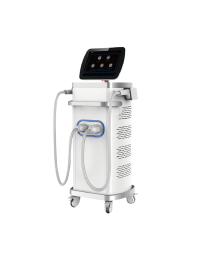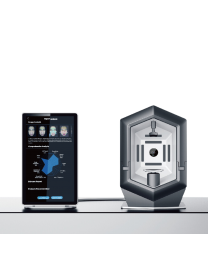Authorized Reseller
The Switched ND: YAG laser is a popular choice for tattoo removal due to its ability to effectively break down tattoo ink pigments. It uses high-intensity light pulses at 1064 nm (for darker inks like black and blue) and 532 nm (for lighter inks like red and orange). The laser energy is absorbed by the tattoo ink, breaking it into smaller particles that the body can naturally eliminate over time. The "switched" feature allows for precise targeting, reducing the risk of skin damage and promoting faster healing compared to older technologies. Multiple sessions may be required for optimal results.
The Switched ND: YAG laser is a highly effective and advanced technology used for tattoo removal. This laser works by emitting light at specific wavelengths, typically 1064 nm (infrared) and 532 nm (green), which are selectively absorbed by the different ink pigments in tattoos. The laser’s energy is delivered in short, intense pulses that target the tattoo ink, fragmenting it into smaller particles. These particles are then gradually broken down by the body’s natural immune system and eliminated through the lymphatic system. For tattoos, the 1064 nm wavelength is particularly effective for treating darker ink colors, such as black and blue, while the 532 nm wavelength targets lighter colors, such as red, orange, and yellow. The laser’s precision allows it to treat ink without significantly affecting the surrounding skin tissue, reducing the risk of scarring or pigmentation changes. The "switched" aspect of the ND: YAG laser refers to the technology that enables it to deliver these high-energy pulses in quick bursts, which is crucial for effectively breaking down the tattoo ink without causing excessive heat buildup in the skin. This quick switching mechanism helps to minimize discomfort for the patient and decreases the likelihood of thermal damage to surrounding tissue, promoting faster recovery times. Tattoo removal with the Switched ND: YAG laser typically requires multiple treatment sessions, spaced several weeks apart, to effectively target and break down the ink. The number of sessions varies depending on factors such as the size, color, and depth of the tattoo, as well as the type of ink used. Over time, the tattoo fades as the ink particles are progressively cleared from the skin. This technology is known for its ability to achieve optimal results with minimal risk of side effects, making it a preferred choice for both medical professionals and patients seeking tattoo removal. However, it’s important for individuals to consult with a certified professional to determine the best treatment plan tailored to their specific tattoo and skin type.
| Benefits |
|
|---|---|
| FAQs | 1. What is the Switched ND: YAG laser? 2. How does the Switched ND: YAG laser work for tattoo removal? 3. How many sessions are required for tattoo removal? 4. Is the Switched ND: YAG laser safe? 5. Does tattoo removal with the ND: YAG laser hurt? 6. What are the side effects of ND: YAG laser tattoo removal? 7. How long does it take to see results from tattoo removal? 8. Can the ND: YAG laser be used for other skin treatments besides tattoo removal? 9. Is there any downtime after treatment? 10. Can the ND: YAG laser be used on all skin types? 11. How much does tattoo removal with the Switched ND: YAG laser cost? 12. Are the results permanent? 13. Can the ND: YAG laser remove all types of tattoos? 14. How can I prepare for an ND: YAG laser tattoo removal session? 15. What happens if I don’t follow aftercare instructions? |
| Brand | ADSS |
1. Tattoo Removal Primary Use: The Switched ND: YAG laser is most commonly used for removing tattoos. It can effectively target a wide variety of tattoo ink colors, including darker shades (black, blue) with the 1064 nm wavelength and lighter shades (red, orange) with the 532 nm wavelength. Best for: Removing tattoos of all sizes, from small to large, and of various ink colors. It's also effective for treating tattoos that are difficult to remove with other methods.
2. Pigmented Lesions Hyperpigmentation: The ND: YAG laser is used to treat various types of pigmentation disorders, such as sun spots, age spots, and freckles. It targets excess melanin in the skin, breaking it down for natural removal. Best for: Reducing the appearance of dark spots or irregular pigmentation caused by sun exposure, aging, or hormonal changes.
3. Vascular Lesions Spider Veins & Capillaries: The Switched ND: YAG laser can treat small vascular lesions like spider veins or broken capillaries. The 1064 nm wavelength is absorbed by hemoglobin in blood vessels, causing the veins to coagulate and be reabsorbed by the body. Best for: Treating vascular issues like spider veins, rosacea, or small varicose veins.
4. Skin Rejuvenation Collagen Stimulation: The ND: YAG laser can be used for skin rejuvenation, stimulating collagen production and improving skin texture. This helps in reducing fine lines, wrinkles, and signs of aging. Best for: Skin tightening, wrinkle reduction, and improving overall skin tone and texture.
5. Acne Scar Treatment Scar Reduction: The laser can be used to treat acne scars by promoting collagen remodeling and reducing pigmentation from old acne scars. Best for: Treating both active acne lesions and the residual scarring left by past breakouts.
6. Hair Removal Laser Hair Removal: The ND: YAG laser can be used for permanent hair removal, particularly in darker skin tones. It targets melanin in hair follicles, inhibiting future hair growth. Best for: Safe hair removal for patients with darker skin tones or those with coarse, dark hair.
7. Stretch Marks Stretch Mark Treatment: The laser can help reduce the appearance of stretch marks by stimulating collagen production and promoting skin healing. Best for: Improving the texture and color of stretch marks, especially those that are newly formed.
8. Tattoo Fading (For Cover-ups) Pre-Modification for Cover-ups: Before getting a new tattoo design to cover an existing one, the ND: YAG laser can help fade the original tattoo, making space for the new design to be more vibrant and clear. Best for: Patients who wish to alter or cover existing tattoos with new artwork.
9. Pigmented Birthmarks Removal of Birthmarks: The ND: YAG laser can effectively treat pigmented birthmarks (such as café-au-lait spots), targeting the excess pigment and lightening the area. Best for: Lightening pigmented birthmarks or irregular pigmentation.
10. Wrinkle Reduction and Skin Tightening Skin Tightening: The laser’s energy stimulates collagen production, improving skin elasticity and reducing fine lines and wrinkles. Best for: Non-invasive skin rejuvenation, particularly around the face, neck, and décolletage.
11. Skin Resurfacing Fractional Resurfacing: The ND: YAG laser can be used for fractional skin resurfacing, improving the texture and tone of the skin by removing layers of damaged skin. Best for: Treating skin imperfections such as sun damage, fine lines, and textural irregularities.
